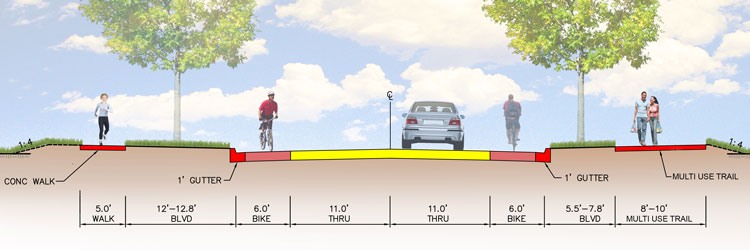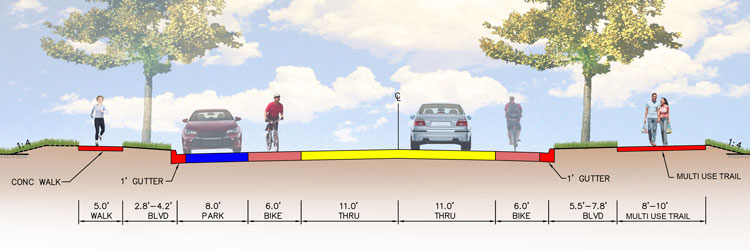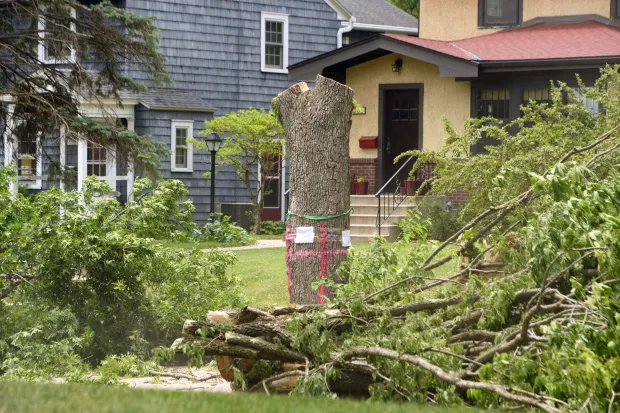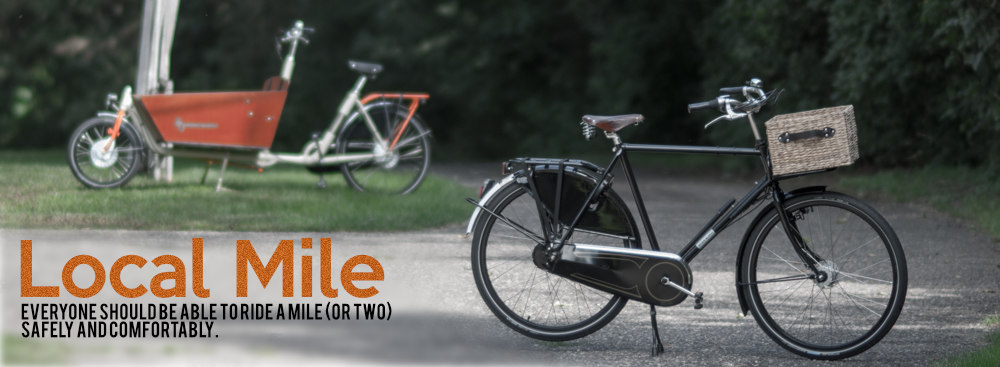Ramsey County is redoing Cleveland Avenue from Larpenteur to Como and in the process removing many large healthy old growth trees.
The proposed design includes two section types; without parking and with parking.


The core of this design, and the cause of so many trees being removed, is a single 34’ – 42’ element of contiguous pavement that includes motorway lanes, bike lanes and parking.
One oddity of this, similar to some other Ramsey County roads, is the inclusion of both on-street painted bike lanes AND shared multi-use trails or SMUTs for bicycle riders. They are, strangely and unnecessarily, separating bicycle riders in to two classes (and then also combining slower 3 MPH walkers with faster and heavier 11-14 MPH bicycle riders and those with disabilities using mobility devices on a SMUT – go figure). Besides increasing risk this is a senseless waste of space.
Fundamentally this is caused by Ramsey County not designing bikeways to CROW specifications and so ‘faster’ riders (sometimes called MAMILs or Middle Aged Men In Lycra though there are many women, LGBTQ+, BIPOCs and others who are considered ‘faster’) want a place where they can ride 15-20-25 MPH with low/no delay at crossings. Bikeways designed to CROW specifications allow for both higher speeds and low/no delay at crossings, they work well for ALL bicycle riders, but these are not designed to that standard.
Wide contiguous bits of paving like this result in higher car/truck speeds and more critically lower driver attention. They also result in more car/truck noise than the same amount of pavement broken in to separate pieces.
Safety
Some of the safety problems with this design include;
1) Painted Bike Lane. About 46%, nearly half, of all bicycle deaths in the U.S. are cars veering from a motorway lane in to a painted bike lane or shoulder like this design includes. Dutch and most other European road engineers have long since learned that paint is insufficient to protect people from drivers and that concrete curb protected bikeways and walkways are the only safe design.
2) Door Zone Bike Lane. These are dangerous on two levels. The first is drivers opening their doors into or in front of bicycle riders who may be going 20 MPH or faster. The second is that drivers must cross over the bike lane to enter or exit a parking space. In both of these, while drivers will look for cars (that pose a threat to them) before opening a door or pulling out of a parking space, they rarely look for or see bicycle riders.
So not only do bicycle riders in these painted bike lanes face risk from drivers on the roadway to their left but also from drivers parking on their right. This is half of the reason that bicycle riders are 13 times as likely to be killed on a road designed by U.S. engineers as one designed by Dutch, Swedish or other EU engineers.
3) Two-Way Multi-Use Trail (MUT). The problem here is that bicycle riders choosing to ride here instead of the much less safe on-street painted lanes will, about 40-50% of the time, be riding counterflow to traffic. Drivers crossing MUTs like this typically look to their left for approaching car traffic that is a threat to them but they very often do not look to their right for bicycle riders or people with disabilities moving counterflow approaching from their right.
Two-way can work well in some cases though. However, EVERY crossing must be properly signed and the bikeway (and walkway) raised/tabled and color coded so that it is made extremely obvious to drivers that they need to look to their right for people walking, wheeling and bicycling.
4) Long Crossing Distances. People walking, bicycling or with disabilities must cross 36’ of roadway with motor traffic going in two directions and some or many inattentive through drivers along with two lanes of ‘faster’ bicycle riders. So 4 lanes of moving vehicles that must all be navigated at once with no safe refuge – frogger in real life. A CROW design separates these, often in to 4 separate 10’ crossings (or occasionally two combined in to 19-20’ maximum) which is much safer and much less stressful.
5) 11’ Wide Motorways. These tell drivers that this is a higher speed throughway. Drivers not only drive faster but worse, pay less attention – to people who may be crossing, riding in a bike lane, etc. 8.5’ to 9.5’, the standard in Europe for a roadway like this, would be much safer.
6) 34’ to 42’ of Contiguous Pavement. Same messaging to drivers that this is a higher speed and low attention throughway rather than a local street that requires greater driver attention.
7) Shared Multi-Use Trail (SMUT). Safer countries try to avoid these as they are uncomfortable for all users, particularly those walking and they pose a minor safety risk. Bicycle riders and those with disabilities using mobility devices should be separated from those walking. For more on this see Sustainable Safety and the booklet: Sustainable Safety 3rd Edition. Also Enabling The Disabled.
8) Lack of Trees. Trees directly adjacent to motor vehicle lanes actually increase safety because they make the road feel more dangerous to drivers so drivers pay better attention (hitting a tree will damage them far more than hitting a person). Removing these and having wider contiguous pavement cause drivers to feel like their attention is not as necessary. As well, trees provide critical shade in summer and shed their leaves to allow warming sunlight in winter – a great design and we’re not using them.
These are only a few of the elements of this design that violate safer CROW principles and that make this a dangerous design for people walking, bicycling or with disabilities. A somewhat more exhausting (in list and long read) look is Hodgson Road.
Increased Through Traffic
This design with 11’ wide motor vehicle lanes allow this to act as a through route for ‘through traffic’ – people going between 35W and Como for example. Besides the increase in traffic itself, through drivers have a different mentality, a ‘I just want to get to my destination’ mentality. Through drivers are not as attentive as local drivers who are just beginning or ending their journey.
CROW design principles, Sustainable Safety, take a very different approach and make this actually, and in feel, a street for local traffic only rather than a road for faster through traffic. CROW design principles say that people driving motor vehicles and not going some place local should choose Hiway 280 or Snelling Avenue, both of which are much more appropriate for through traffic.
This will likely not see anywhere near as much through traffic as other routes where Ramsey County and CROW differ but it will increase through traffic a little, and each less attentive through driver is a higher risk to people who live, work, walk, wheel and bicycle in this neighborhood. And each adds additional stress, noise and pollution.
A Safer Design
Here is how this road would be designed in European and other countries using CROW principles.

This CROW design has numerous advantages:
- Much Safer – for all ages and all abilities including ‘faster’ riders.
- Preserves Trees.
- Quieter, less car/truck noise.
- Preserves local community/neighborhood feel
A key design differentiator is that the painted bike lanes of the Ramsey County design have been separated from the roadway and are now wider one-way curb protected bikeways that safely serve all bicycle riders and those with disabilities. There is also a separate walkway on each side. This provides numerous safety benefits for all users with no drawbacks and the same or less paving.
It’s important to note for the ‘faster’ bicycle riders that these protected bikeways, when designed to CROW standards, provide for higher speeds and low/no delay at crossings. These are also much safer for all users than either the on-street painted bike lanes or two-way SMUTs in the current Ramsey County designs. I have ridden on protected bikeways like these with UCI Pro Team Rabbobank as well as others on training rides at higher speeds and they work quite well. If they are good enough for professional bicycle racers then they should certainly be good enough for faster riders.
Interestingly, bicycle racers in Europe I have talked with are confused by American’s insistence on having on-street painted bike lanes. These Europeans want just the opposite because they don’t want the risks of painted bike lanes and car doors. This perhaps because their engineers design much better bikeways for all users.
While the 10’ bikeways in this plan are ideal, they can be as narrow as 7-8’ and still function fairly well (so long as they are one-way with a separate walkway). These EQUALLY serve BOTH higher speed MAMILs as well as the majority of bicycle riders who are not higher speed but only want a safe place to ride from point A to point B. Similarly, 6’ walkways allow for two or three people to walk comfortably side by side and allow for others to pass in the same or opposite direction. Narrower (or wider) can work as well if necessary.
The design proposed by Ramsey County is why someone, adult or child, riding a bicycle here is 9-13 times as likely to be killed as someone riding a bicycle in The Netherlands (or Denmark or Sweden or every other developed country). The CROW design principles are much safer and have proven to be safer over several decades of use.
Trees
The current engineering design, a single very wide contiguous pavement, is resulting in the county removing numerous healthy old growth trees in this neighborhood.
THIS IS COMPLETELY UNNECESSARY.
 Tree removal along Cleveland Avenue a few months after I originally published this article. (Scott Takushi / Pioneer Press)
Tree removal along Cleveland Avenue a few months after I originally published this article. (Scott Takushi / Pioneer Press)
A CROW design results in 5 separate and narrower ribbons; two walkways, two bikeways and one motorway. Each can be placed however necessary to preserve trees. So rather than a single 34-42’ central section that results in tree removal, a CROW design has only a 20.5’ central section (or 29’ with a parking bay) which will easily fit without removing as many or likely any existing trees.
The bikeways and walkways can be placed however necessary to preserve as many trees as possible and likely preserve all trees.
Noise
Several elements will result in increased noise:
- Wider contiguous pavement. Contiguous propagates noise more than non-contiguous.
- Higher Speeds
- Increased through traffic?
- Removal of trees
A CROW design significantly reduces contiguous pavement, higher speeds and will preserve trees.
Update: June 2022

Despite pleas from the neighborhood and others to reconsider the design and reconsider their routing more through traffic through this neighborhood, Ramsey County proceeded with tree removal to make way for the wider and faster Cleveland Avenue.
While initially saying that 56 large trees would be removed from this neighborhood, at the last minute Ramsey County announced that 167, three times as many and the vast majority of all large trees along this corridor would be removed.
* Tree removal photo: Scott Takushi, Pioneer Press
